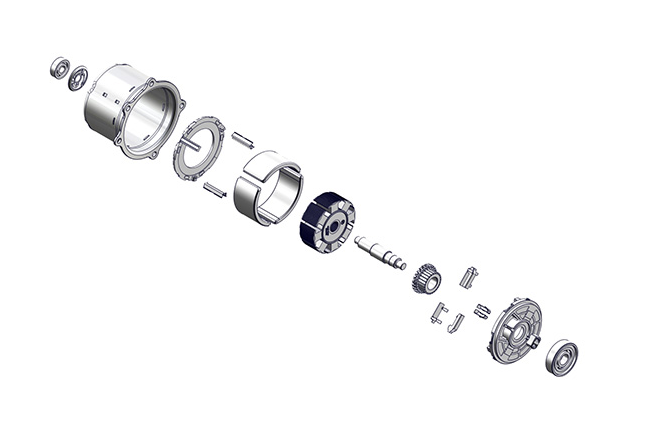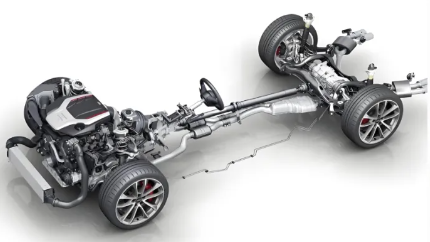Air suspension, also known as pneumatic suspension, is a suspension system that utilizes compressed air as the elastic element, replacing the metal springs found in traditional suspensions. By controlling the pressure within the springs, it achieves automatic height adjustment and optimization of shock absorption performance. As an integral part of modern automotive suspension technology, air suspension systems have secured a place in the automotive market with their superior comfort and adaptability.
A. Key Components of Air Suspension Systems
Air springs: The core component of the air suspension system, these are primarily made of rubber and fabric, filled with compressed air. Air springs can adjust air pressure as needed, thereby changing the spring stiffness and the vehicle’s ground clearance.
Control Unit: It acts as the system's brain, responsible for receiving signals from various sensors, such as vehicle speed, acceleration, steering angle, and so on, and adjusting the air pressure in the air springs based on these signals to achieve optimal suspension performance.
Sensors: Multiple sensors are present in the air suspension system, including height sensors, pressure sensors, and acceleration sensors. These sensors collect vehicle status information and transmit it to the control unit for corresponding adjustments.
Air Compressor and Air Tank: The air compressor compresses and delivers air to the air springs, while the air tank serves as a container for storing compressed air. The combination of the air compressor and air tank ensures that the air suspension system can quickly respond to the control unit’s commands.
Solenoid Valves: Key components for controlling airflow, they open or close according to the control unit’s instructions, thereby regulating the air pressure in the air springs.
Shock Absorbers: Although air springs provide the main support and buffering effect, shock absorbers are still necessary to further absorb and control the vehicle’s vibrations and impacts. Adjustable damping shock absorbers are commonly used, which can adjust the damping coefficient according to road conditions.
Connecting Parts and Brackets: These parts fix the air springs, shock absorbers, and other components to the vehicle’s chassis, ensuring the stability and reliability of the suspension system.
Electronic Control Software: Modern air suspension systems are usually equipped with advanced electronic control software, capable of implementing more complex suspension adjustment strategies, such as adaptive suspension control, automatic level adjustment, and so on.
User Interface: It allows the driver to manually adjust the suspension settings according to personal preferences or specific driving conditions, such as raising or lowering the vehicle height.
Diagnostic System: The air suspension system is usually equipped with a diagnostic interface for fault detection and system maintenance.

B. Working Principle of Air Suspension Systems
The working principle of the air suspension system is based on the principles of aerodynamics and fluid dynamics, dynamically adjusting the vehicle’s suspension by regulating the air pressure in the air springs. The details are as follows:
The air suspension system works by adjusting the air pressure inside the air springs to change the vehicle body height and shock absorption effect. Specially, when the vehicle is in motion, the body height sensor detects the distance between the vehicle body and the ground and sends signals to the electronic control unit. The electronic control unit then controls the air compressor to inflate or deflate the air springs, thereby adjusting the air pressure.
Raising the Vehicle Body: When the vehicle body needs to be raised, the electronic control unit instructs the air compressor to inflate the air springs, increasing the air pressure. As the air springs expand, they lift the vehicle body, increasing the vehicle body height.
Lowering the Vehicle Body: When the vehicle body needs to be lowered, the electronic control unit instructs the air exhaust valve to open, releasing air from the air springs. As the air pressure in the air springs decreases, the vehicle body descends, reducing the vehicle body height.
Adjusting Shock Absorption Effects: The air suspension can also adjust the shock absorption effect by regulating the air pressure in the air springs. When the road surface is smooth, the electronic control unit reduces the air pressure in the air springs, making the suspension softer and improving ride comfort. When the road surface is uneven, the electronic control unit increases the air pressure in the air springs, making the suspension firmer, and enhancing vehicle handling and stability.
C. Air Suspension States
There are three states of air suspension systems:
1. Holding State: When the vehicle is lifted by a lift, the air suspension system closes the relevant solenoid valves while the computer memorizes the vehicle's body height, maintaining the original height after the vehicle lands.
2. Normal State: During driving, if the vehicle body height changes beyond a certain range, the air suspension system will adjust the vehicle body height at regular intervals.
3. Awakening State: When the air suspension system is awakened by the remote control key, door switch, or trunk lid switch, the system checks the vehicle body height through the body level sensor. If the vehicle body height is lower than the normal height by a certain extent, the air tank will provide pressure to raise the vehicle body to the normal height. At the same time, the air suspension can adjust the shock absorber hardness, including soft, normal, and hard states (also marked as comfort, normal, and sport modes, etc.), and the driver can control it through the control button in the car.
D. Advantages of Air Suspension Systems
Air suspension can automatically or manually adjust the height and hardness of the shock absorption according to different road conditions and driving needs, adapting to various complex terrains and environments, and improving vehicle trafficability and stability. For example, when the vehicle is traveling at high speed, the air suspension can lower the vehicle body height, reduce wind resistance, and improve fuel economy and safety; when the vehicle is traveling on a bumpy road, the air suspension can raise the vehicle body height, increase the ground clearance, reduce chassis scraping, and improve comfort and durability.
Air suspension can automatically or manually adjust the level of the vehicle according to the vehicle’s load, maintaining the vehicle’s balance and posture, and improving the vehicle’s carrying capacity and braking performance. For example, when the vehicle load increases, the air suspension can increase the air pressure in the airbags, raising the vehicle body to prevent the vehicle body from sinking, maintaining wheel-ground contact, and improving braking performance; when the vehicle load decreases, the air suspension can reduce the air pressure in the airbags, lowering the vehicle body to prevent the vehicle body from floating, maintaining the stability of the vehicle body, and improving handling.
Air suspension can automatically or manually adjust the damping of the shock absorber according to the vehicle’s driving state, thereby changing the stiffness of the vehicle’s suspension, and improving the vehicle’s comfort and handling. For example, when the vehicle is traveling on a smooth road, the air suspension can reduce the damping of the shock absorber, increase the softness of the suspension, absorb the subtle vibrations of the road surface, and improve the comfort of riding; when the vehicle is cornering or braking urgently, the air suspension can increase the damping of the shock absorber, increase the rigidity of the suspension, reduce the body’s roll and pitch, and improve the vehicle’s handling and safety.
In summary, the benefit of air suspension is that it can adjust the vehicle’s height, level, and the hardness of the shock absorption according to different situations, achieving the best driving effect, and improving the vehicle’s comfort and handling.

E. Disadvantages of Air Suspension Systems
High Cost: The manufacturing and maintenance costs of air suspension are relatively high, usually only equipped in high-end models, which may not be cost-effective for ordinary consumers.
Difficult and Expensive Maintenance: Due to the complex components of the air suspension, such as air springs, shock absorbers, compressors, and so on, these parts may fail or be damaged, causing the air suspension system to fail or work abnormally, with high maintenance costs.
Strict Load Requirements: Strict requirements for cargo weight, attention must be paid not to overload when loading, otherwise it will reduce the service life of the air suspension.
In summary, although air suspension is excellent in improving vehicle performance and comfort, its high cost and maintenance costs limit its application in ordinary models.
F. About HONEST Automation
The HONEST Automation’s Automotive Air Suspension Motor Production Line is configured with a conveyor line + automatic machine method, equipped with high-precision sensors, vision detection systems, and a complete line data collection system, ensuring stable and orderly production processes and process tracking. Moreover, there is no need to worry about personnel safety issues, as we have equipped all manually operated equipment with dedicated safety light grids, safety door locks, and other personal safety protection measures.
Are you interested in our production line or equipment? Contact us for more information or to discuss your specific needs.





